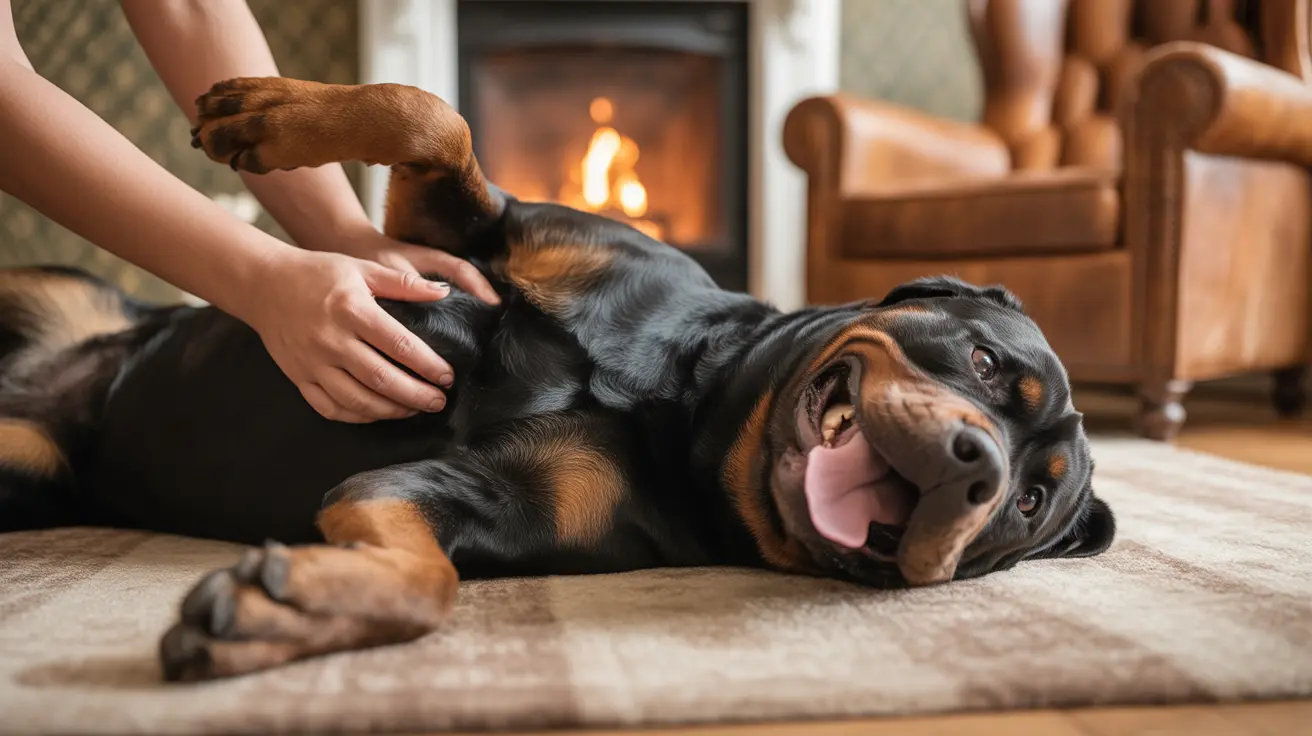Introduction
Rottweilers are known for their distinctive vocalizations, with growling being one of their most common forms of communication. While many people associate dog growling with aggression, Rottweilers actually growl for various reasons, ranging from expressing happiness to alerting their owners about potential threats. Understanding why Rottweilers growl is crucial for owners to properly interpret their pet's emotions and respond appropriately.
In this comprehensive guide, we'll explore the different types of Rottweiler growls, what they mean, and how to distinguish between happy, warning, and stress-related vocalizations.
The Famous "Rottie Rumble": Happy Growling
One of the most endearing characteristics of Rottweilers is their unique "Rottie rumble" – a soft, purr-like growl that indicates contentment and happiness. This vocalization often occurs during pleasant interactions such as:
- Receiving belly rubs or pets
- Playing with family members
- Greeting loved ones
- Relaxing with their favorite toys
The happy growl is accompanied by relaxed body language, including a loose wagging tail, soft eyes, and a generally calm demeanor. This behavior is so distinctive that it's often compared to a cat's purr, showing just how comfortable and content your Rottweiler feels.
Warning and Protective Growls
As natural guardians, Rottweilers may also growl to communicate potential threats or discomfort. These protective vocalizations serve as important warning signals and should not be ignored or punished. Warning growls typically occur when:
- Strangers approach their territory
- Unknown dogs come too close
- Someone approaches their food or toys
- They feel threatened or cornered
These growls are usually accompanied by tense body language, raised hackles, and a more rigid posture.
Medical and Stress-Related Growling
Sometimes, increased growling can indicate underlying health issues or stress. Pay particular attention if your normally quiet Rottweiler suddenly becomes more vocal, as this could signal:
- Physical pain or discomfort
- Anxiety or fear
- Joint problems
- Dental issues
- Other medical conditions
Always consult with a veterinarian if you notice sudden changes in your dog's vocalization patterns.
Training and Socialization
Proper training and socialization are essential for managing Rottweiler growling behaviors. Early exposure to different people, animals, and environments helps prevent fear-based growling and builds confidence. Consider these training approaches:
- Positive reinforcement techniques
- Professional training classes
- Controlled socialization experiences
- Consistent boundaries and rules
Reading Your Rottweiler's Body Language
Understanding the context of your Rottweiler's growls requires paying attention to their overall body language. Look for these indicators:
Happy Body Language
- Relaxed muscles
- Soft, blinking eyes
- Loose, wagging tail
- Open, relaxed mouth
Warning Body Language
- Stiff posture
- Hard, fixed stare
- Raised hackles
- Tense facial muscles
Frequently Asked Questions
Why do Rottweilers growl when they are happy or playful?
Rottweilers growl when happy as part of their natural communication style, often called the "Rottie rumble." This gentle, purr-like growl is accompanied by relaxed body language and is their way of expressing contentment and pleasure.
How can I tell the difference between a happy growl and an aggressive growl in my Rottweiler?
Happy growls are typically softer, accompanied by relaxed body language and wagging tails. Aggressive growls are usually louder, deeper, and come with tense body posture, raised hackles, and potentially bared teeth.
What does it mean if my Rottweiler growls when meeting strangers or new environments?
This type of growling often indicates uncertainty or protective instincts. It may suggest your Rottweiler needs more socialization or is feeling uncomfortable in new situations.
Could my Rottweiler's growling be a sign of pain or discomfort?
Yes, sudden increases in growling, especially during specific movements or when touched in certain areas, could indicate pain or discomfort. Consult your veterinarian if you notice these changes.
How should I respond if my Rottweiler growls to seek attention or protect their territory?
Never punish growling, as it's an important communication tool. Instead, address the underlying cause through training, establish clear boundaries, and work with a professional trainer if needed.
Conclusion
Growling is a natural and important part of Rottweiler communication. By understanding the different types of growls and their contexts, owners can better respond to their dog's needs and maintain a healthy, trusting relationship. Remember that professional guidance from trainers or veterinarians is always available if you need help interpreting or addressing your Rottweiler's vocalizations.






